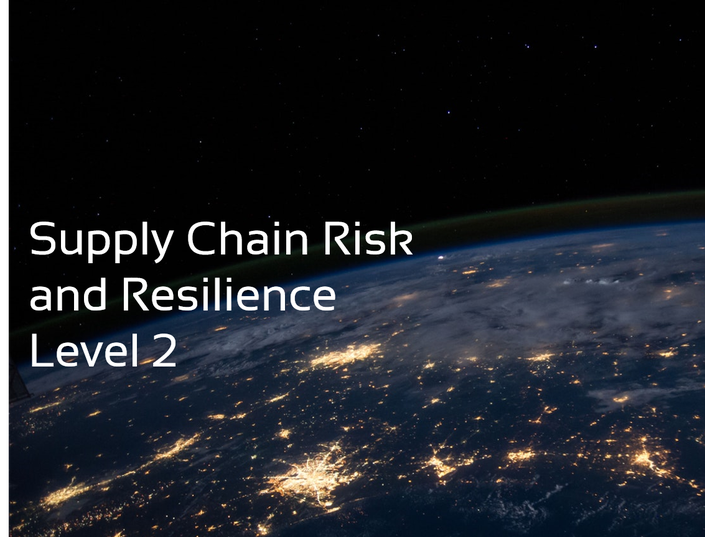
Supply Chain Risk and Resilience Level 2
Operationalizing the present-day tools, techniques, methodologies, metrics, frameworks and solutions to make these enablers work for you to drive SCR&R
Introduction
Surveys and studies have concluded that, for a variety of reasons, supply chain risk is increasing globally and that supply chain resilience is increasingly a competitive differentiator. The financial impact of supply chain disruptions can be devastating and are often not understood until it is too late. Supply chain strategies driven primarily by cost management and delivery improvements are no longer comprehensive enough to ensure competitive success. Unfortunately, showing a hard ROI for risk management initiatives is a difficult sell.
This new course provides knowledge and tools to guide you through understanding the choices available to your organization to manage supply chain risk and enhance the resiliency required for long term sustainability and profitability. Structured in three levels, in Level 2 we aim to help you better define the components of risk and resilience, to articulate the financial benefits of better risk management. You will acquire knowledge and insight in Level 2, in order to identify, assess, mitigate and manage supply chain risks.
In Level 3, toolsets will be developed and case studies offered that delve into the impact of risk on various aspects of your organization.
It is no longer sufficient for supply chain strategies to be primarily driven by cost management and delivery improvements. As a learner, upon completion of the three levels, you will acquire knowledge and insight that enables you to identify, assess, mitigate and manage supply chain risks. This will culminate in earning the Supply Chain Risk and Resiliency Certificate
Scope of this Course
Level 2 will provide a tremendous amount of new content that will assist you in operationalizing the present-day tools, techniques, methodologies, metrics, frameworks and solutions to make these enablers work for you and drive the Supply Chain Risk & Resiliency journey forward.
While supply chain management has evolved, in terms of improving organizations’ efficiency and profitability by applying tools, methods and new technology, vulnerabilities and risks continue to be exposed through globalization of the supply chain arena. Level 2 combines the maturity of supply chain management and the emerging new SCR&R tools, techniques, metrics and frameworks into a more comprehensive approach to identifying, assessing, mitigating and managing supply chain risk and ensuring a resilient supply chain.
The course utilizes current research and best practices applied in global supply chains including “Supply Chain Risk Management: An Emerging Discipline,” Schlegel and Trent, CRC/Press, published in 2015. Level 2 will leverage online resources, video clips from exemplar companies, personal interviews with the authors, Global Risk Indexes and much more to provide additional insight and clarity.
Skills you will learn
Gain further understanding behind the drive for good supply chain risk and resiliency
Gain further appreciation for new software solutions supporting all aspects of supply chain risk & resiliency
Learn about emerging risk frameworks and protocols to ensure good SCR&R returns on your investments
Learn how to identify, assess and mitigate supply chain risks using new statistical tools and techniques
Gain knowledge regarding your own company’s Risk Appetite/Risk Frontier and culture utilizing new assessment models
Gain an understanding of methodologies that can forecast supplier bankruptcy 15-18 months in advance with a 90% accuracy rate
Increase your awareness of the importance of supply chain cyber security and countermeasures
Who Should Attend
Aspiring supply chain professionals who seek to understand the dynamics of Supply Chain Risk and Resilience (SCR&R).
Learners who work in risk management and finance, information management, supply chain management, logistics, procurement, manufacturing, operations and distribution will benefit from the SCR&R Body of Knowledge.
As we mentioned, Level 1's intention was to set the foundation for SCR&R Body of Knowledge. Levels 2 and 3 will expand on those foundations.
Certification
Completing Supply Chain Risk and Resilience Level 1, 2 and 3 will confer upon the learner the Supply Chain Risk and Resiliency Certificate.
Course Team

Gregory L. Schlegel, CPIM, CSP, Jonah
Greg is Founder of The Supply Chain Risk Management Consortium- (22) companies who bring skills, solutions and methodologies that Identify, Assess, Mitigate and Manage Enterprise Risk. He has been a Supply Chain Executive for several Fortune 100’s, has been a Supply Chain Executive Consultant for IBM, is Executive-in-Residence at Lehigh University teaching Supply Chain Risk Management, Adjunct Professor teaching Enterprise Risk Management for Villanova University’s EMBA program and VP/Principal at SherTrack LLC.
Greg has presented papers on and has managed consulting engagements in supply chain management, Risk Management, Predictive Analytics, Probabilistic Modelling, Lean/Six Sigma and Theory of Constraints throughout the US and around the globe. Greg was APICS’ 1997 International Society President. He is well published, a frequent speaker at conferences, seminars, webinars and dinner meetings. Greg and Dr. Robert J. Trent, of Lehigh University, have co-authored a new book, “Supply Chain Risk Management: An Emerging Discipline.” Greg speaks over 20 times per year at conferences and workshops and has authored over 100 articles in major supply chain magazines and journals.
Irvin Varkonyi, CSCP, CLTD, PLog
Irvin is a certified instructor with the DC Metro chapter of APICS, teaching their Certified Supply Chain Professional (CSCP) and Certified in Logistics and Transportation Distribution (CLTD) programs. Mr. Varkonyi’s career has encompassed the global transportation and logistics system working with global carriers and Third Party Logistics. He holds an MBA from the Thunderbird School of Global Management and a B.A. in International Relations and Economics from Clark University. He teaches Transportation Security, focusing on the intersection of public policy and global business in managing risk in our systems to move people, goods and information as well as efficient and resilient transportation systems.
